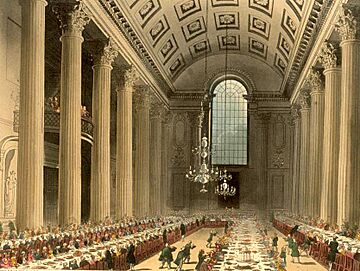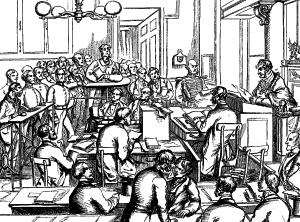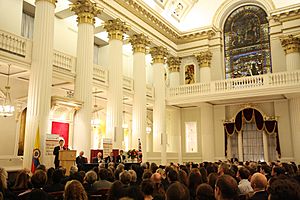Mansion House, London facts for kids
Quick facts for kids Mansion House |
|
|---|---|
 |
|
| General information | |
| Architectural style | Palladian |
| Town or city | London, EC4 |
| Country | United Kingdom |
| Current tenants | Lord Mayor of London |
| Construction started | 1739 |
| Design and construction | |
| Architect | George Dance the Elder |
The Mansion House is the official home of the Lord Mayor of London. It is a very important historical building, known as a Grade I listed building. This means it's protected because of its special history and design. The building was designed by George Dance the Elder in a style called Palladian, and most of it was built in the 1740s.
The Mansion House is used for many important events for the City of London. These include two big annual dinners where guests wear formal "white tie" clothes. At the Easter dinner, a main speaker is the Foreign Secretary, who talks about international relations. In early June, the Chancellor of the Exchequer gives a speech about the British economy. A famous speech given here was by David Lloyd George in 1911. He warned the German Empire about going against British influence before the First World War.
Contents
History of the Mansion House
The Mansion House was built between 1739 and 1752. It was designed in the Palladian style by George Dance the Elder, who was an architect and surveyor. Before the Mansion House was built, the area was a market called Stocks Market. The City of London wanted a proper home for the Lord Mayor. Before this, the Lord Mayor had to stay in different halls belonging to City companies, which was not very convenient.
Building the Mansion House was tricky because there were springs (small streams) underground. Workers had to sink many piles (long poles) into the ground to make sure the foundations were strong enough.
The original building had two unusual roof extensions. People nicknamed them the "Mayor's Nest" and "Noah's Ark." Over the years, parts of the building were changed. In 1795, George Dance the Younger (George Dance the Elder's son) put a new roof over the central courtyard. He also had the "Noah's Ark" part taken down. Later, in 1842, the "Mayor's Nest" was also removed. The building has been updated many times to make it more useful for the Lord Mayor and the City.
How the Mansion House Was Paid For
The way the Mansion House was funded was quite unusual. The City authorities, who were all members of the Church of England, found a way to tax other Christian groups. These groups were often called "Dissenters" because they "dissented" or disagreed with the official Church of England.
In 1748, the City of London Corporation created a tricky rule to raise money. They passed a law that said if a man refused to run for an important City job, or refused to serve if elected, he would have to pay a large fine. However, to serve in a job like Sheriff of the City of London, a person had to have taken part in a special Church of England service recently. This was something many Dissenters could not do because of their beliefs.
So, the City of London would often elect wealthy Dissenters to these jobs. They knew these people could not serve because of their faith. When the Dissenters refused, the City would fine them. This way, the City collected a lot of money, about £15,000, which was a huge amount back then. Some of the people chosen were even blind or sick in bed, showing how unfair the system was.
One man named Evans fought this unfair system in court for ten years. Finally, in 1767, a high court ruled that the City could not force Dissenters to pay these fines. This ruling helped protect people from such unfair treatment.
The American writer Mark Twain even wrote about this story in his book A Connecticut Yankee in King Arthur's Court. He described how the City of London used this clever, but unfair, method to get money for the Mansion House.
Architecture and Design
The Mansion House has three main floors above a stone basement. The front of the building has a grand entrance with six tall columns. These columns support a triangular section above them, which has a sculpture. This sculpture shows a figure representing the City of London.
The main room for events is called the "Egyptian Hall." It was given this name because the architect, George Dance, used a special arrangement of columns that was thought to be "Egyptian" at the time. However, there are no actual Egyptian designs or symbols in the room. This hall has twenty spaces for sculptures.
The Mansion House also used to have its own court of law. This was because the Lord Mayor is the chief judge of the City while in office. There were also holding cells for prisoners. A famous person held here was Sylvia Pankhurst, a women's rights activist from the early 1900s.
Art Collection
The Mansion House is home to a wonderful art collection called the Harold Samuel Collection. It has many beautiful Dutch and Flemish paintings from the 1600s. This collection is considered one of the best of its kind in Britain. It includes 84 paintings by famous artists like Hendrick Avercamp, Frans Hals, and Jan Steen. The Mansion House also has a collection of valuable silver and gold items, including five special ceremonial swords used by the City of London.
Visiting the Mansion House
The Mansion House is not usually open to the public every day. However, you can arrange tours through their office. There are also public tours available on most Tuesdays.
Mansion House Street
Mansion House Street is a short street right in front of the Mansion House. It connects several other important streets in London, like Poultry and Queen Victoria Street. It is also above the Bank Underground station.
Other Important City Buildings
The Guildhall is another important building in the City of London. It is also used for many significant City events and functions.
See also
 In Spanish: Mansion House (Londres) para niños
In Spanish: Mansion House (Londres) para niños





